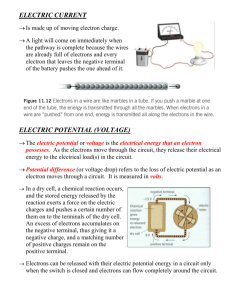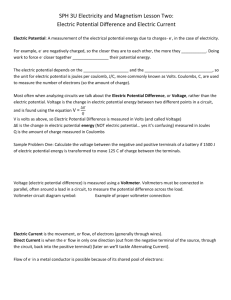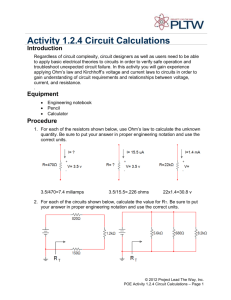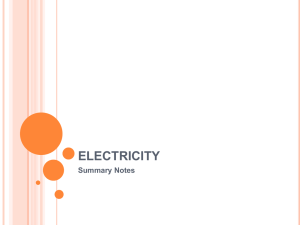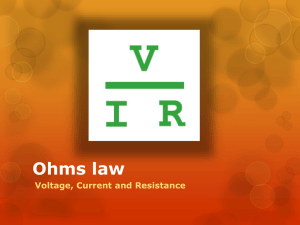July 26
advertisement
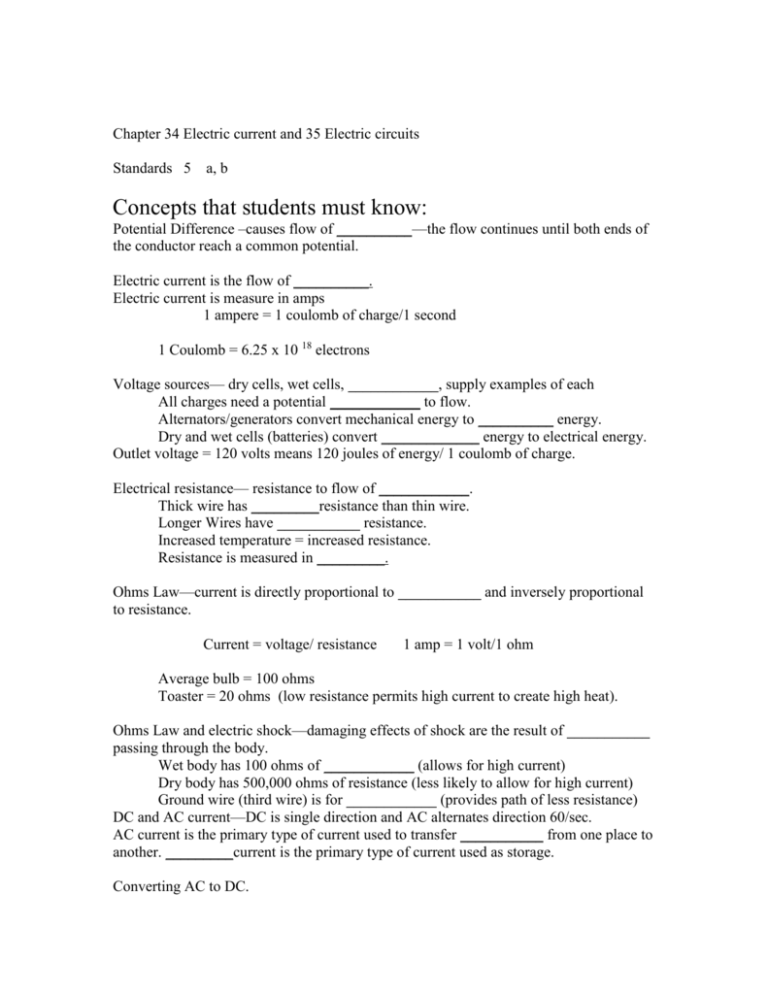
Chapter 34 Electric current and 35 Electric circuits Standards 5 a, b Concepts that students must know: Potential Difference –causes flow of __________—the flow continues until both ends of the conductor reach a common potential. Electric current is the flow of __________. Electric current is measure in amps 1 ampere = 1 coulomb of charge/1 second 1 Coulomb = 6.25 x 10 18 electrons Voltage sources— dry cells, wet cells, ____________, supply examples of each All charges need a potential ____________ to flow. Alternators/generators convert mechanical energy to __________ energy. Dry and wet cells (batteries) convert _____________ energy to electrical energy. Outlet voltage = 120 volts means 120 joules of energy/ 1 coulomb of charge. Electrical resistance— resistance to flow of ____________. Thick wire has _________resistance than thin wire. Longer Wires have ___________ resistance. Increased temperature = increased resistance. Resistance is measured in _________. Ohms Law—current is directly proportional to ___________ and inversely proportional to resistance. Current = voltage/ resistance 1 amp = 1 volt/1 ohm Average bulb = 100 ohms Toaster = 20 ohms (low resistance permits high current to create high heat). Ohms Law and electric shock—damaging effects of shock are the result of ___________ passing through the body. Wet body has 100 ohms of ____________ (allows for high current) Dry body has 500,000 ohms of resistance (less likely to allow for high current) Ground wire (third wire) is for ____________ (provides path of less resistance) DC and AC current—DC is single direction and AC alternates direction 60/sec. AC current is the primary type of current used to transfer ___________ from one place to another. _________current is the primary type of current used as storage. Converting AC to DC. Diodes are devices that are “one way” valves that allow __________ flow in _____ direction only. A capacitor stores the filtered half cycle (time delay) to smooth out the pulse output. [Demonstrate on board]. Electric fields travel through circuits at nearly the speed of light, but electron do ________. The speed of electron flow—DC electricity travel at approx 1 meter in 3 hours. AC electricity reverses direction 60 times /sec and therefore electrons stay at the _________ place. The source of electrons in a circuit—Electrons already in the conductor. Electrons vibrate Energy comes from the outlet—(Power Company energy company) 120 volts = 120 joules/1 coulomb (6 x 1018 electrons) Energy, not electrons, comes from wall _________. Electric Power—rate at which electric energy is converted into another form of ________ is power. 1 watt = 1 ampere x 1 volt 60 watts = .5 amps x _______volts 1 kilowatt = ________ watts 1 kilowatt hour = 1000 kilowatts x 1 ________ . Chapter 35 Battery and bulb Discuss construction of bulb. Electric circuits—circuit cannot have any gaps (__________) Series circuit—__________ path way for electrons to flow between terminals of battery. Parallel circuit—has branches, each of which is a separate path for the flow of _________. Important characteristics of Series circuits— 1. Electric _________ has a single pathway through the circuit. 2. The current is resisted by the ______ of the resistance of all devices along the circuit. 3. The current is numerically the voltage of the source divided by the __________ resistance of the circuit (Ohms law). 4. Ohms law applies separately to each device—the voltage drops across ________ device depends directly on its (each device) resistance. 5. The sum of the individual voltage drops is __________ to the voltage of the source. The main disadvantage of a series circuit is that if one device fails _________ of the devices in the circuit will work. Homes are wire in Parallel so that a device can be ___________ without affecting the operation of any other devices. Parallel circuits—electrical devices connected to the same __________ points of an electric circuit. Important characteristics of Parallel circuits— 1. Each device connects the same two points and the ___________ is therefore the same across each device. 2. The total __________ divides among the parallel branches. Current passes more readily into devices of low resistance, so the current in each branch is ___________ proportional to the resistance of the branch. Ohms law applies separately to each branch. 3. The total current in the circuit is equal to the _________ of the currents in parallel branches. 4. As the number of parallel branches is increased, the overall resistance of the circuit is ____________. This means the overall resistance is less that any one (resistance) of the branches. Schematic diagrams; Symbols are used to represent certain circuit elements. Discuss battery symbols 1. Resistor symbol 2. Wire 3. Open switch 4. Closed switch Combining resistors in a compound circuit Use concept Dev Practice 35 to demonstrate this process Use work sheets to practice. Parallel circuits and overloading-- Because adding more branches in a ___________ circuit decreases total resistance, more current is used. Lines that carry an unsafe amount of current are said to be ____________ which may melt insulation and cause a fire. Fuses –devices connected in ________ to protect a circuit from overload. Fuse ribbon melts and must be replaced. Circuit breakers—device connected in __________ to protect from overload. Device uses magnets and bimetallic strips to open the switch when it senses too much _________. The breaker must be turned off and then back on after the overload condition is repaired.

